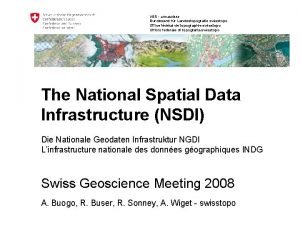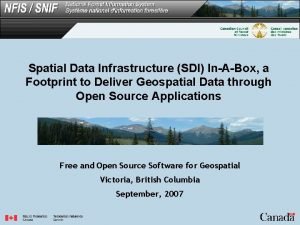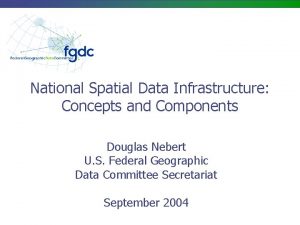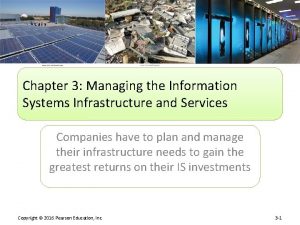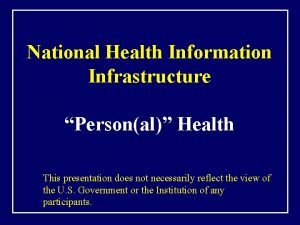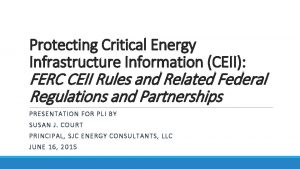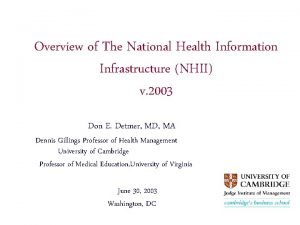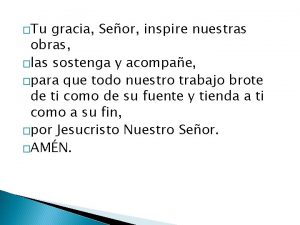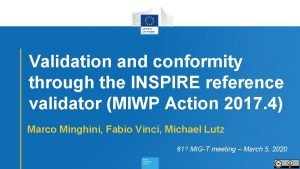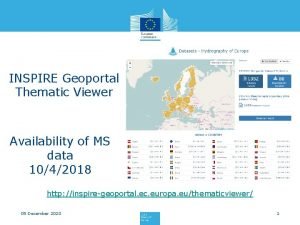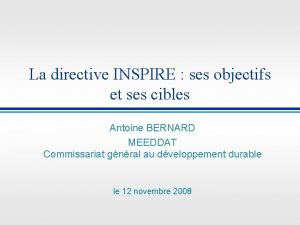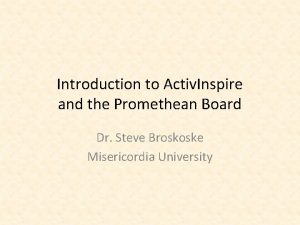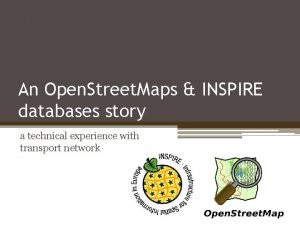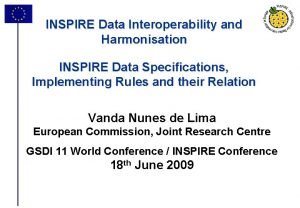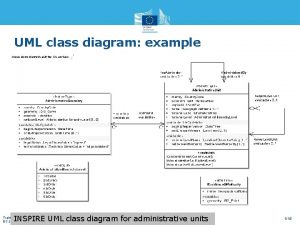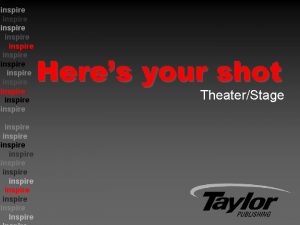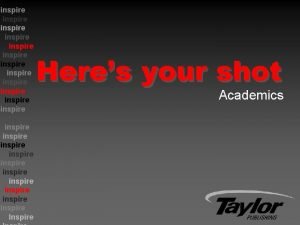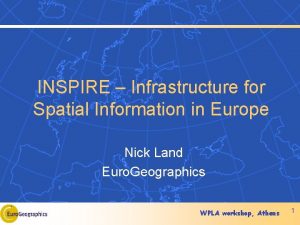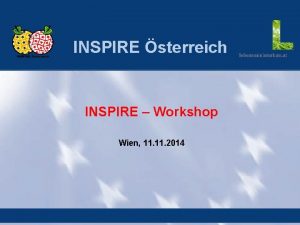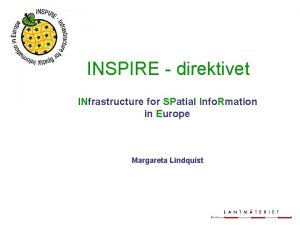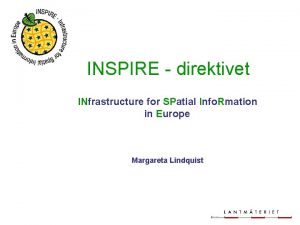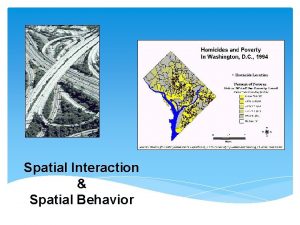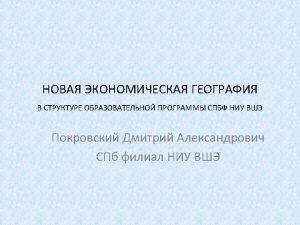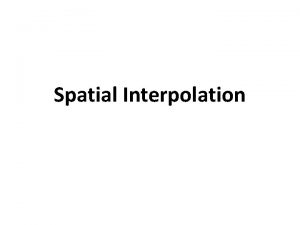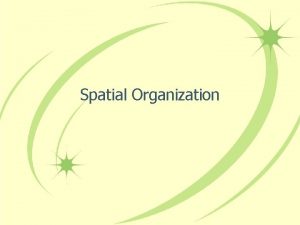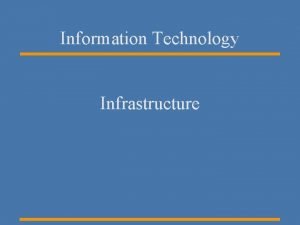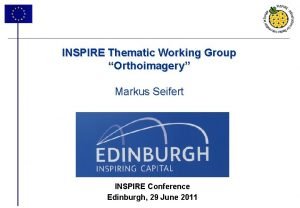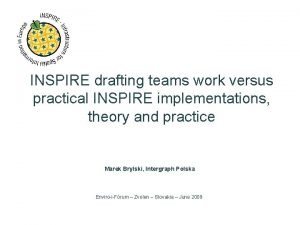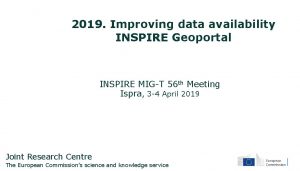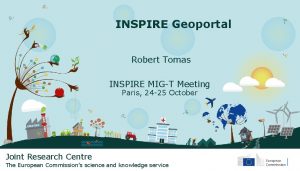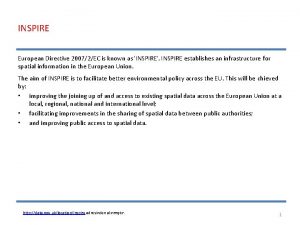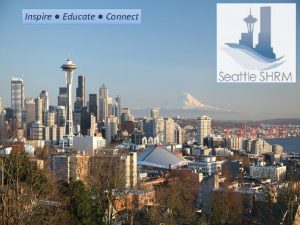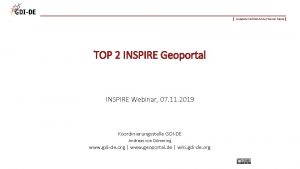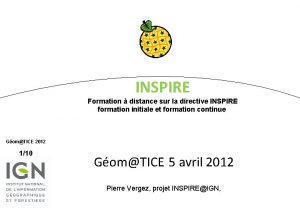INSPIRE Infrastructure for Spatial Information in Europe Michael



























- Slides: 27

INSPIRE: Infrastructure for Spatial Information in Europe Michael Lutz FGDC Standards WG meeting, 18 June 2015 www. jrc. europa. eu Serving society Stimulating innovation Supporting legislation

Why Europe needs a spatial data infrastructure (SDI)? https: //www. youtube. com/watch? v=PZc. RZWi. Ex 6 M

INSPIRE Directive • General rules to establish an Infrastructure for Spatial Information in Europe for § Community environmental policies § Policies or activities which impact on the environment • Built on the SDIs of the 28 EU Member States § Spatial data held by public authorities, in 34 data themes and 24+ languages § No requirement to collect new data • INSPIRE is a Framework Directive § Detailed technical provisions in Implementing Rules • JRC is the technical coordinator

INSPIRE in a nutshell • Which data sets exist? • I cannot access them • Who owns it? How can I access it? What’s the scope? What’s the quality? • I cannot view or download it • I don’t understand the data and map content

INSPIRE thematic scope Annex I 1. Coordinate reference systems 2. Geographical grid systems 3. Geographical names 4. Administrative units 5. Addresses 6. Cadastral parcels 7. Transport networks 8. Hydrography 9. Protected sites Annex II 1. Elevation 2. Land cover 3. Ortho-imagery 4. Geology Implementation 2012/2017 Implementation 2015/2020 Annex III 1. 2. 3. 4. 5. 6. Statistical units Buildings Soil Land use Human health and safety Utility and governmental services 7. Environmental monitoring facilities 8. Production and industrial facilities 9. Agricultural and aquaculture facilities 10. Population distribution – demography 11. Area management/ restriction/regulation zones & reporting units 12. Natural risk zones 13. Atmospheric conditions 14. Meteorological geographical features 15. Oceanographic geographical features 16. Sea regions 17. Bio-geographical regions 18. Habitats and biotopes 19. Species distribution 20. Energy Resources 21. Mineral resources

INSPIRE vs. FGDC framework themes Annex I 1. Coordinate reference systems 2. Geographical grid systems 3. Geographical names 4. Administrative units 5. Addresses 6. Cadastral parcels 7. Transport networks 8. Hydrography 9. Protected sites Annex II 1. Elevation 2. Land cover 3. Ortho-imagery 4. Geology Annex III 1. 2. 3. 4. 5. 6. Statistical units Buildings Soil Land use Human health and safety Utility and governmental services 7. Environmental monitoring facilities 8. Production and industrial facilities 9. Agricultural and aquaculture facilities 10. Population distribution – demography 11. Area management/ restriction/regulation zones & reporting units 12. Natural risk zones 13. Atmospheric conditions 14. Meteorological geographical features 15. Oceanographic geographical features 16. Sea regions 17. Bio-geographical regions 18. Habitats and biotopes 19. Species distribution 20. Energy Resources 21. Mineral resources

A collaborative effort • Transparency and inclusiveness • Stakeholder consultations • Support to Member States on the implementation • Extend INSPIRE to and ensure consistency of different policy domains • Promote INSPIRE in international standardisation

INSPIRE specifications 6 legal acts 40+ Technical Guidelines

Implementing Rules (IRs), IRs) Technical Guidelines (TGs) and tools “What Member States must implement” (abstract specification) legally binding Directive INSPIRE Directive 2007/2/EC Commission Regulation Implementing Rules not legally binding “How Member States might implement it” (implementation specification) Technical Guidelines Tools implementing INSPIRE requirements e. g. TGs for the Implementation of Download Services INSPIRESOS TGs – Data Specification on Addresses INSPIRE validator Extended schemas

References to international standards Directive INSPIRE Directive 2007/2/EC (mainly ISO/TC 211) Commission Regulation Implementing Rules Many references to standards Technical Guidelines Some references to standards (OGC, ISO/TC 211 and domain-specific) Tools implementing INSPIRE requirements e. g. TGs for the Implementation of Download Services INSPIRESOS TGs – Data Specification on Addresses INSPIRE validator Extended schemas

Standards used in INSPIRE AAA W 3 C LDP CS-W WMS, WMTS ISO 19115, 19119, 19139 Atom, WFS, SOS, WCS next slide… ISO 19115, 19119, 19139

Data interoperability – standards stack EPBD+EED reporting WFD reporting MSFD reporting ITS BU ER HY EF OF Generic conceptual model ISO 19100 MSFD Marine Strategy Framework Directive WFD Water Framework Directive ITS Intelligent Transport Systems AC/ MF … SR TN … OGC standards Domain standards EPBD Energy Performance of Buildings Directive EED Energy efficiency of Buildings Directive

Data interoperability – standards stack EPBD+EED reporting WFD MSFD reporting ITS … INSPIRE extensions & applications reporting BU ER HY EF OF AC/ MF SR TN … INSPIRE Generic conceptual model ISO 19100 MSFD Marine Strategy Framework Directive WFD Water Framework Directive ITS Intelligent Transport Systems OGC standards Domain standards EPBD Energy Performance of Buildings Directive EED Energy efficiency of Buildings Directive

INSPIRE maintenance & implementation

Why? Support MS in implementation http: //inspire. jrc. europa. eu/index. cfm/pageid/44

Why? Maintain 6 legal acts and 40+ Technical Guidelines

Why? Develop and maintain central infrastructure components and tools

Why? INSPIRE RDF GEO- Support technical evolution and use of INSPIRE data & services

Why? Coordinate with other policies and discuss strategic direction

How? • Maintenance and Implementation Framework (MIF) set up by the Commission, in agreement with the Member States • Coordinated by Commission Expert Group on INSPIRE Maintenance & Implementation (MIG) with representatives of the Member States § Technical and policy sub-groups (MIG-T and MIG-P) • Following a rolling work programme (MIWP) • MIWP actions executed through temporary sub-groups • Supported by a pool of INSPIRE implementation experts

MIWP – On-going actions • MIWP-5: Validation and conformity testing • MIWP-6: Registries and registers • MIWP-7 a: Extension of Download Service TG for observation data (based on SOS) • MIWP-7 b: Extension of Download Service Technical Guidelines for Web Coverage Services (WCS) • MIWP-8: Update of Metadata TG • MIWP-14: Theme-specific issues of data specifications & exchange of domain-specific implementation experiences • MIWP-16: Improve usefulness and reliability of monitoring • MIWP-21: Pilots for INSPIRE-based applications

Find out more • INSPIRE web site § http: //inspire. ec. europa. eu/ • MIG collaboration platform § http: //tinyurl. com/MIG-Platform • Thematic clusters § https: //themes. jrc. europa. eu

INSPIRE: Infrastructure for Spatial Information in Europe Additional slides www. jrc. europa. eu Serving society Stimulating innovation Supporting legislation

Data interoperability The starting point … user • Access to spatial data in various ways user. . . Transformation dataset • User has to deal with interpreting heterogeneous data in different formats, identify, extract and post-process the data he needs lack of interoperability

Data interoperability user . . . and what INSPIRE is aiming at user. . . Standardised access Network Service Transformation dataset • Provide access to spatial data via network services and according to a harmonised data specification to achieve interoperability of data ! Datasets used in Member States may stay as they are ! Data or service providers have to provide a transformation between their internal data model and the harmonised data specification

Key pillars of data interoperability Conceptual data models • objects types, properties & relationships • cross-domain harmonization • based on a common modelling framework • managed in a common UML repository Encoding Harmonised vocabularies • conceptual models independent of concrete encodings • achieve better interoperability than free-text and/or multilingual content • standard encoding: GML, but also possible to derive other encodings (e. g. based on RDF) • allow additional terms from local vocabularies • 400 code lists & almost 5000 values in central register Registers • provide unique and persistent identifiers for reference to resources • allow their consistent management and versioning

Cross-sector/-border interoperability Data from other sectors INSPIRE data SD: Species distribution energy EL: Elevation PD: Population Distribution health emissions s work et port n s n a r TN: T ER: Energy Resources US: Utilities and Governmental Services (Waste Management) PF: Production and industrial facilities AF: Agricultural and aquaculture facilities SO: Soil HB: Habitats and biotopes Smart cities Environmental Impact Assessment Risk Management BU: Buildings AM: Area management/ restriction/ regulation zones & reporting units …
 Oflinemaps
Oflinemaps National spatial data infrastructure
National spatial data infrastructure National spatial data infrastructure
National spatial data infrastructure Spatial data infrastructure components
Spatial data infrastructure components Infrastructure information system
Infrastructure information system National health information infrastructure
National health information infrastructure Ceii ferc
Ceii ferc Itil information technology infrastructure library
Itil information technology infrastructure library National health information infrastructure
National health information infrastructure Que tu gracia señor inspire nuestras obras
Que tu gracia señor inspire nuestras obras Inspire vs motivate
Inspire vs motivate Gmc software ag
Gmc software ag How do artists inspire future generations
How do artists inspire future generations Inspire rcs
Inspire rcs Inspire validator
Inspire validator Inspire geoportal
Inspire geoportal How do inventors inspire our imaginations
How do inventors inspire our imaginations Directive inspire
Directive inspire Promethean activ board
Promethean activ board Inspire databases
Inspire databases Gratifying predict meaning
Gratifying predict meaning Set high expectations which inspire motivate and challenge
Set high expectations which inspire motivate and challenge Inspire data specifications
Inspire data specifications Inspire risk management
Inspire risk management Inheritage
Inheritage Inspire orlando
Inspire orlando Larne high school pe kit
Larne high school pe kit Integrative medicine vancouver
Integrative medicine vancouver

